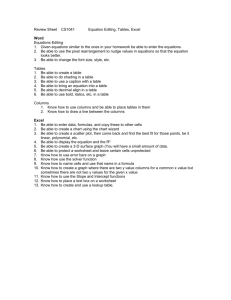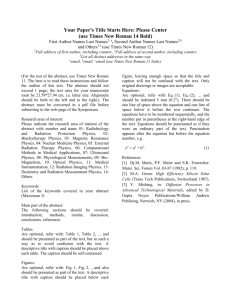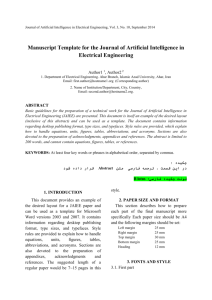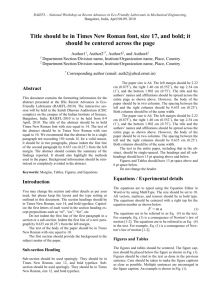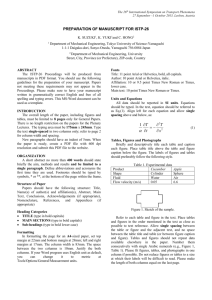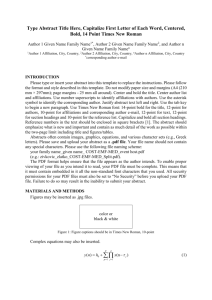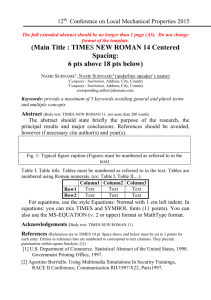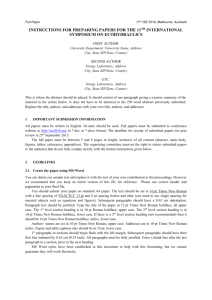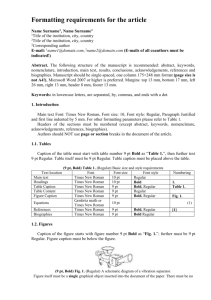docx
advertisement
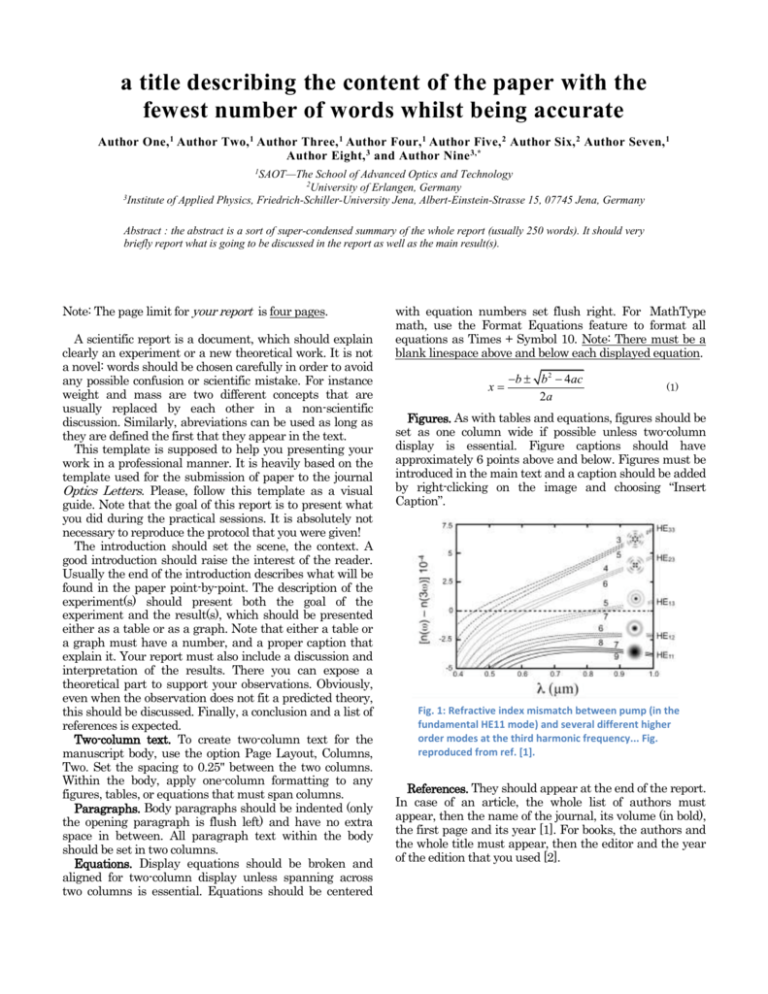
a title describing the content of the paper with the fewest number of words whilst being accurate Author One, 1 Author Two, 1 Author Three, 1 Author Four, 1 Author Five, 2 Author Six, 2 Author Seven, 1 Author Eight, 3 and Author Nine 3,* 1SAOT—The School of Advanced Optics and Technology of Erlangen, Germany 3Institute of Applied Physics, Friedrich-Schiller-University Jena, Albert-Einstein-Strasse 15, 07745 Jena, Germany 2University Abstract : the abstract is a sort of super-condensed summary of the whole report (usually 250 words). It should very briefly report what is going to be discussed in the report as well as the main result(s). Note: The page limit for your report is four pages. A scientific report is a document, which should explain clearly an experiment or a new theoretical work. It is not a novel: words should be chosen carefully in order to avoid any possible confusion or scientific mistake. For instance weight and mass are two different concepts that are usually replaced by each other in a non-scientific discussion. Similarly, abreviations can be used as long as they are defined the first that they appear in the text. This template is supposed to help you presenting your work in a professional manner. It is heavily based on the template used for the submission of paper to the journal Optics Letters. Please, follow this template as a visual guide. Note that the goal of this report is to present what you did during the practical sessions. It is absolutely not necessary to reproduce the protocol that you were given! The introduction should set the scene, the context. A good introduction should raise the interest of the reader. Usually the end of the introduction describes what will be found in the paper point-by-point. The description of the experiment(s) should present both the goal of the experiment and the result(s), which should be presented either as a table or as a graph. Note that either a table or a graph must have a number, and a proper caption that explain it. Your report must also include a discussion and interpretation of the results. There you can expose a theoretical part to support your observations. Obviously, even when the observation does not fit a predicted theory, this should be discussed. Finally, a conclusion and a list of references is expected. Two-column text. To create two-column text for the manuscript body, use the option Page Layout, Columns, Two. Set the spacing to 0.25" between the two columns. Within the body, apply one-column formatting to any figures, tables, or equations that must span columns. Paragraphs. Body paragraphs should be indented (only the opening paragraph is flush left) and have no extra space in between. All paragraph text within the body should be set in two columns. Equations. Display equations should be broken and aligned for two-column display unless spanning across two columns is essential. Equations should be centered with equation numbers set flush right. For MathType math, use the Format Equations feature to format all equations as Times + Symbol 10. Note: There must be a blank linespace above and below each displayed equation. x b b 2 4ac 2a (1) Figures. As with tables and equations, figures should be set as one column wide if possible unless two-column display is essential. Figure captions should have approximately 6 points above and below. Figures must be introduced in the main text and a caption should be added by right-clicking on the image and choosing “Insert Caption”. Fig. 1: Refractive index mismatch between pump (in the fundamental HE11 mode) and several different higher order modes at the third harmonic frequency... Fig. reproduced from ref. [1]. References. They should appear at the end of the report. In case of an article, the whole list of authors must appear, then the name of the journal, its volume (in bold), the first page and its year [1]. For books, the authors and the whole title must appear, then the editor and the year of the edition that you used [2]. Table 1. Specifications for this Template Item Paper Size Margins Typography Title Authors Affiliations Corresponding E-mail History Abstract OCIS Paragraph Table Figure Caption Equation References A4 Top 0.75, Bottom 0.75, Left 0.69, Right 0.69 Indentation Font Name Font Size (pts.) (inches) Times New Roman 19 0.63 Times New Roman 10 0.37 Times New Roman 9 0.37 Times New Roman 9 0.37 Times New Roman 8.5 1.6 Times New Roman 9 0.68 Times New Roman 8.5 0.75 Century 10 Century Century Century Century Alignment Center Center Center Center Center Justified Left Justified 9 9 10 Center 9 Justified References 1. J. Nold, P. Hölzer, N. Joly, G. Wong, A.Nazarkin, A. P. and M. Scharrer, and P. S. Russell, Opt. Lett. 35, 2922 (2010). 2. J. Reintjes, Nonlinear optical parametric processes in liquids and gases (Academic Press, 1984). Notes Bold Bold Italic Italic Two lines Two columns; Indent 0.13 Table title bold 6 pt above and below Equation number flush right Bold heading

